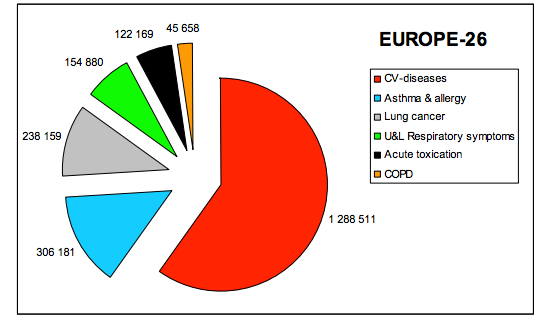Importance of IAQ
Today, there is an increased awareness of the co-relation between IAQ and health. Multiple scientific studies have published research that confirms that poor indoor air quality (IAQ) can greatly affect individuals and, more broadly, the public health and national productivity. In a recent report, the Institute of Medicine concluded that “there is sufficient evidence of an association between exposure to a damp indoor environment and asthma symptoms in sensitized asthmatic people” and that “there is a sufficient evidence of an association between the presence of ‘mold’ in a damp indoor environment and asthma symptoms in sensitized asthmatic people.” Asthma affects an estimated 20 million Americans and costs the US economy more than $13 billion annually.
Since most of us spend more than 90% of our time indoors, we are susceptible to exposure to poor IAQ even greater than our exposure to outdoor air. Additional symptoms include headaches, nasal congestion, skin irritation, dry cough, exhaustion, joint pain and many other disorders.
Hence, good IAQ is extremely important for a healthy indoor environment in your building. Optimal IAQ not only enhances the quality of occupants’ health, comfort and productivity but also have a market advantage over other buildings.
IAQ maintenance Strategy
Maintaining good IAQ requires conscious efforts by both building staff as well as occupants of the building. Assigning one person responsibility to address the challenges around IAQ is a good place to start. This person would be accountable for policy, maintaining standards and ensuring the tasks needed to maintain the IAQ are implemented. They also need to have the ability to quickly react to any complaints that are received and take corrective action. Frequent inspections play a critical role in identifying problem areas and fixing them before anyone complains about it.
In large buildings indoor air quality is complex involving many factors and sometimes attempts to control the situation might not be effective. In such cases, finding professional services to assist you with their IAQ services would save you money in the long run. These professionals take a look at the design and usage of the buildings, the interiors of the buildings and determine if they should bring in mechanical engineers and sometimes even industrial hygienists.
Whether you are a facility manager, energy management vendor or IAQ professional service provider: ROI points: https://iaqscience.lbl.gov/performance-cost.
1. Reduced energy use
According to a study conducted by US Environmental Protection agency, the economic loss due to poor indoor air quality was in “tens of billions” of dollars per year and hence any modest investment towards good indoor air quality would generate substantial results.
Any modifications to the buildings – either structurally or due to internal systems have always impacted IAQ problems. For example, by reducing the flow of outdoor ventilation air always results in poor IAQ. IAQ also required a clean and better-controlled HVAC system and this always results in reduced energy use.
In fact, the energy needed to distribute air ventilation and maintain optimal air quality in buildings is not much when compared to problems such as reduced productivity of occupants.
The main factors that influence the indoor air quality are airflow, thermal conditions, lighting and presence of odors and pollutants. Hence the expenses incurred to improve equipment, systems and cleaning of air pollutants might ultimately reduce energy spent for trying to maintain the temperature and air quality.
In addition, a study conducted by the Berkeley labs, explores the correlation between staff costs and the total building energy costs. For every dollar spent on maintaining optimal temperature, there have been economic benefits per worker as well.
This is listed in the table below.

Source: Berkeley Labs study of Cost Effectiveness of Improving Indoor Environments to Increase Productivity
The study also demonstrated the cost benefit analysis of changing the ventilation rates. For example, they observed that the estimated financial benefits of improved work performance was around $600 per worker (based on $100K per worker) when the ventilation rate was changed between 15-20 cfm per person that produced an estimated improvement in performance around 0.6%.
2. Increases occupant health and productivity:
There is no doubt that clean indoor air had important health benefits but it also has significant impact on vulnerable groups like babies, children and the elderly. This is obviously of utmost importance in buildings like schools, universities and hotels. Today there are multiple studies conducted in various parts of the world to record the impact of indoor air quality and public health. These scientific studies note that various respiratory diseases like asthma, allergies and certain types of cancers that are associated with asbestos, radon and environmental tobacco smoke.
You might think that the quality of indoor air depends on the outdoor air, but there are other factors that are responsible for indoor air control like emissions within the building from equipment, ventilation rates, use of cleaning products or food preparation as well as various other pollutant inducing activities.
According to one study, the total calculated burden of disease attributable to IAQ in EU-26 is ca. 2 million DALYs per year, i.e. two million years of healthy life is lost annually.

Source: Promoting actions for health indoor air by Director General Health and Consumers, EU
IAQ produces both building related diseases as well as non-specific building-related illness (NSBRI), also referred to as sick building syndrome. NSBRI is a condition where individuals develop symptoms from a build-up of irritants in the environment probably associated with poor ventilation. This non-specific illness could include headache, drowsiness, and burning and irritation of the eyes, nose and throat and sometimes cough. The IAQ causes can be biological or chemical but generally are at a concentration too low to cause identifiable disease. The illnesses usually do not culminate into long-term consequences outside the environment.
On the other hand, building-related diseases are more severe in nature. These conditions develop because of exposure to infective, toxic, irritant or immunological agents that are in the pollutants, molds and other harmful disease-causing bad air in the buildings.
Hence it is very important to ensure that indoor air quality of buildings is maintained at very high standards.
3. Increased market value:
Often buildings with good air quality attract tenants, ensure long-term leases and increase market value as well as market share. Buildings often witness the following advantages whenever good indoor air quality is maintained.
- Tenant Retention – Ensuring a good indoor air quality policy, continuous maintenance of air quality results in fewer complaints from occupants and serves as a retention tool. It is proven that building users value indoor air quality over virtually any other environmental or sustainability amenity offered in the workplace.
- Risk Management – Healthy buildings that do their due diligence in IAQ programs show a commitment towards building a healthy and safe environment for employees. Hence, buildings with proactive measures to maintain IAQ are less susceptible to liability.
- Increase market value - Buildings with adequate IAQ programs take care of continuous documentation of their policy, standard and maintenance activities. This results in a competitive advantage during any sale process. The cost of addressing IAQ is more than recovered at sale time when these buildings demonstrate high standards with regards to maintaining healthy buildings and buyers are most likely to invest in buildings with better management facilities especially with high IAQ.
- Brand Value - It has been proven time and again that IAQ is one of the most economically beneficial elements of sustainability and building operations. Studies show maintaining a high quality IAQ results in a 5 to 10 percent improvement in productivity. Hence this is directly related to a bigger economic benefit. Healthy buildings can utilize their IAQ programs as a powerful marketing tool for leasing, extending leases or selling since it makes for a compelling value proposition due to the economic impact.
Conclusion:
In conclusion, you might think that maintaining indoor air quality requires investments in time, effort and resources but the ROI of IAQ more than outweighs those investments. Some of the advantages you get with maintaining good indoor air quality ranges from attracting high-value tenants, retaining leases, saving costs on energy efficiency, improving occupants health and wellness as well as increasing productivity of employees. If you are thinking of introducing IAQ policy, standards and maintenance program, this is the best time to start your process.




